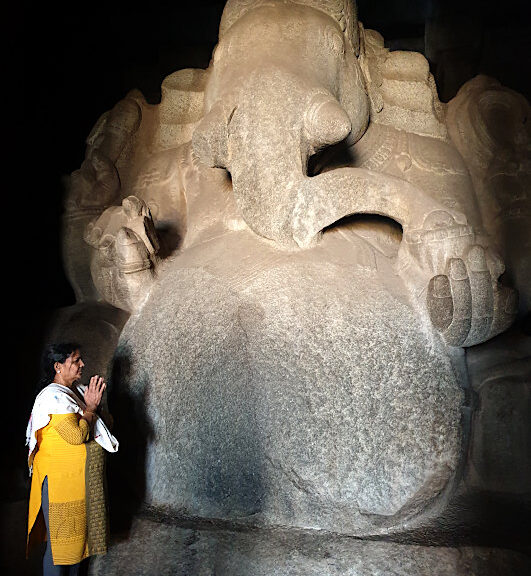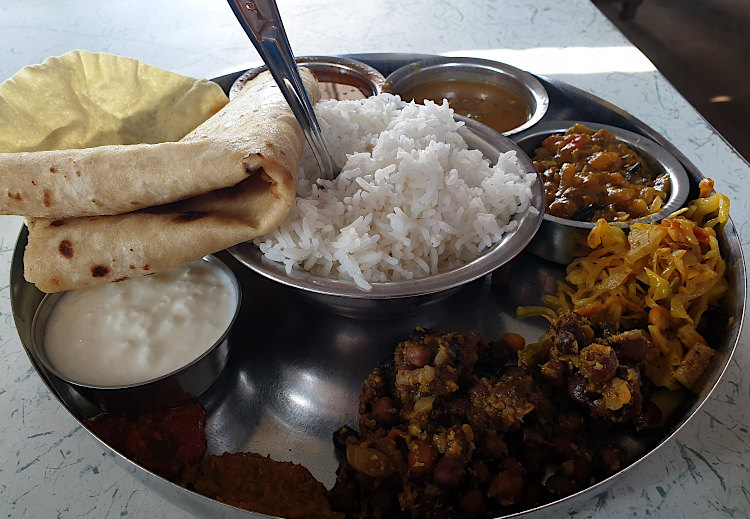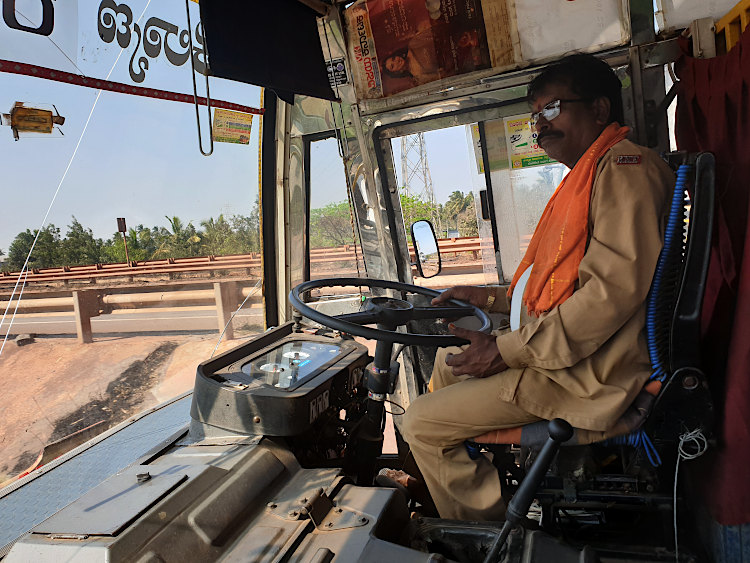
Hampi
Unlike most people’s conceptions of India, there are plenty of areas with a thinly spread population. Northern Karnataka is one such place. Subsequently public transport is rather sporadic, something I had already experienced. So for my next leg I decided to splurge 3500Rs (£35) on renting a car (with driver) for the 150km/4hr trip to Hampi.
The first part of the trip was along narrow potholed roads across agricultural land – mainly sugarcane but also jowari which I found out to be sorghum. Interestingly, it is used to feed animals in the richer parts of southern Karnataka, but here in the poorer north it is a staple of the local people. Wikipedia tells me that sorghum, maize and sugarcane all come from the same family. It was much smoother going once we reached the main highway at Kushtagi. Although the road was very good there was little traffic , predominantly lorries with very few cars or buses. Arriving at Hampi I was surprised, but shouldn’t have been, by the number of tourists. I guess because I had seen so few up till now. But they weren’t foreigners, mainly Indians. Domestic tourism in India is certainly booming.
This was very different to my first trip to Hampi way back in 1994, 29 years ago! No Indian tourists and not that many foreigners. However, I wasn’t impressed: my diary entry says, “My first impressions weren’t great – the first hotel I looked at had no beds and was full of drugged up hippies. Eventually I got a cell in a hotel with no name. It had a concrete bed with a paper thin mattress and a mandi at the end of the corridor” Things have obviously changed. I booked into a fairly simple hotel, Gopi Homestay, but the room was comfortable, with en-suite bathroom (1600Rs).

I chilled out for a few hours and then ventured out in late afternoon. It was much quieter now. I walked past the big temple in the middle of town (Virupaksha Temple) and up Hemakuta hill which itself is covered in many small temples and shrines. Going down the other side I popped in to see the Giant Ganesha carved out of a single huge boulder.

Not far from here is the first big temple complex: the Krishna temple. Despite me saying there were loads of tourists, I was the only one here. Compared to the Badami carvings, I was a bit disappointed with these, as I was with many in Hampi, despite being carved over 800 years later.

By now I was feeling a bit peckish and managed to find a small place serving thalis. Delicious!

It was now getting near the end of the day and Hampi is famous for its sunset points. For my first night I had chosen probably the most famous of them – Matanga Hill. Here were the tourists, and monkeys, but not too many.


Not bad for a first day. Tomorrow my explorations continue with “The Royal Centre”. As usual I was up and out fairly early, to avoid the heat and tourists. I headed south past the Krishna temple to the first monument of the day and one of the most famous, the Shri Lakshmi Narasimha Statue, containing the famous “bug eyed” creature.

From here, another kilometre or so to the Royal enclosure and the first temple in this group, the underground Shiva temple so called because it was built below ground level, resulting in the inner sanctum now being underwater.

From here I passed the Krishna Deveraya Palace area. Just the base survives no doubt because the palace itself was built of wood and totally destroyed when the invading Muslims destroyed the place. However, shortly after was a highlight of the day, the Hazara Raama Temple. Again, I thought the carvings were a bit crude compared with Badami, but even though over 500 years old they looked remarkably pristine. The polished black stone columns were particularly impressive and unusual. It was now almost 9am and warming up a bit, but I was the only tourist about.





From here, past the ruins of the Royal Enclosure past an impressive step well.

I next climbed up the Mahanavami Dibba which is a huge platform probably used to welcome guests and foreign dignitories. The sides are decorated with many figures including hunting scenes and also Turkish and Portuguese traders who were around at the time.
On the edge of the Royal Enclosure is a structure called the Queen’s Bath, although never used by the Queen, it was probably used by the King who had it constructed, King Achyutaraya, and maybe a few of his reputedly 600 wives. What is interesting about it is its distinctive Indo-Islamic architecture.

The Queen’s bath is quite near the nearest town in the area, Kamalapur, so I took a bit of time out for lunch, a very tasty masala dhosa at the restaurant below and then a wander around the old town.


It was now heating up quite considerably, so I got an auto back to Hampi village.

After my usual siesta I headed out in the late afternoon back to the Krishna temple, not to go back in the temple but I noticed earlier there was a small tank there which I thought would be good for bird watching. There were a few things around including lapwings, pond herons and this ibis. There were also a few Indian lads who came for a chat and insisted I take their photo. Made a change I suppose. Normally they want selfies with me!

For tonight’s sunset I chose Hemakuta Hill, much closer to Hampi bazaar and not so steep and so more popular than Matanga hill.



Day Three, 26th February 2023
As I’d stated before Hampi archaeological area is spread out over a large area and there are loads of monuments, most of them free to wander around, however, being a world heritage site, two of the very special ones are closed off and you have to pay the fee of 600 Rs. Unfortunately, these two are very far apart, one the zenana enclosure was in the royal centre where I’d been the previous day and the other, the Vittala temple was a few kilometres to the east of Hampi bazaar. I decided to walk to the Vittala temple first thing in the morning and hopefully get an auto from there to the Zenana enclosure later in the day.
As usual, I set off fairly early heading into the rising sun.

Upon leaving the Hampi bazaar main street the track then skirts the Tungabhadra River and passes the riverside shrine, Kodanda Rama temple with the statues inside carved out of the side of the hillside.

Just around the corner from here is the first major temple, the Shri Achyutaraaya Swami Temple. This was the last main complex to be built (in 1534) before the city was destroyed. Like the other main temples there is a broad market avenue leading up to a large entrance gate. Looking up from here I could see quite a few people on Matanga Hill, presumably there for the sunrise. A couple joined me in the temple for a look around.




Going further east from here is probably the highlight of a trip to Hampi – the Vitthala Temple. As I had set out so early, I had arrived at opening time, 8.30 and there were only a few people about. I paid my 600Rs fee and went in. I must admit the place was really impressive. It was a fairly small compound with a few temples but the sheer number of carvings was astonishing. Interestingly most of them were human rather than Hindu gods and goddesses, including figures of the time including Portuguese horse trainers.









There were a few other temples nearby and then I walked a further kilometre to the car park where more tourists were being unloaded, some of them onto stretch golf carts to take them the full kilometre to the temple. I stopped for a drink and a chat to the Auto drivers. The few that were there had been hired for the day but fortunately I got one guy who would take me the 6 or 7 kilometres back to the Royal Centre. I had paid for my ticket so I could complete the circuit of all (or at least the vast majority) of the Hampi sites.
Back at the Royal Enclosure, where I had been the day before, I saw the Zenana, the Lotus Mahal and Elephant stables. I must admit, they weren’t worth the entrance fee if I had seen them on their own. I remembered my time back in 1994 when I had taken a photo of the elephant stables with a man herding his cattle through the complex. No chance now – just guides herding the tourists.





Hampi Last Day. It was my last day here. I had planned to take it easy which was just as well as I was feeling a bit fatigued and I had a cold coming on. I wandered down to the river in the morning to see the temple elephant taking a bath, followed by a group of eager foreigners. I then decided to go to Anegundi, the village not far from Hampi on the other side of the river. As it happened it turned out quite exciting as I accidentally stumbled upon a village festival. Everyone was dressed up in their finery and going from house to house. There was also a procession down the main street with lots of drummers leading to the town temple where they were ritually slaughtering plenty of goats and chickens. I took lots of photos on my photostream for the day, but I also made a short video:
Returning from Anegundi, I got my stuff together and headed off getting an Auto from Hampi to Hospet and then a bus to Hubli and finally, the overnight train to Goa…



Map of the journey: